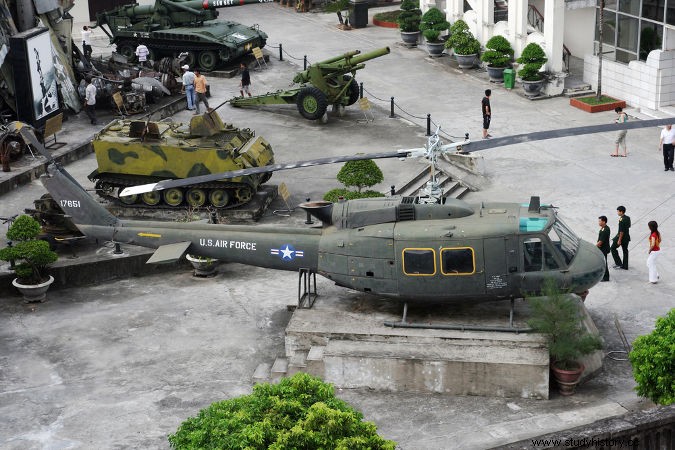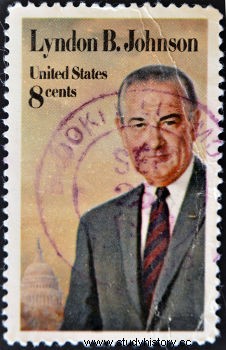
The Vietnam War was a conflict between North Vietnam and Vietnam from South , from 1959 to 1975. This conflict was motivated by ideological issues and had the intense participation of the US army from 1965 to 1973. It is estimated that, in this war, between 1.5 million and 3 million people died.
Conflict Background
The Vietnam War is considered a direct offshoot of another conflict that had taken place in Vietnam from 1946 to 1954:the War da Indochina . In this conflict, Vietnamese linked to the Vietminh had fought French troops to end France's colonial rule in the region called French Indochina.
The end of this war was established at the Geneva Conference in 1954, which further defined the independence of Vietnam in two entities with different governments. Thus, they were created:
-
Vietnam from North :which was ruled by Ho Chi Min , had its capital in Hanoi and was allied with the Soviet Union.
-
Vietnam from South :which was ruled by Ngo Diem Dinh , its capital was Saigon and it was allied with the United States.
During this conference, it was also agreed that the unification of Vietnam would take place on the basis of the results of the 1955 general election. However, the government of the South refused to participate in the elections, claiming not to believe in the ability of the Northern government to conduct free elections. The existing tensions between the two nations were part of the bipolarization context of the Cold War.
The Ho Chi Minh government had thousands of guerrillas undercover who carried out acts of sabotage in South Vietnam. Tensions between the sides gradually increased in the period from 1955 to 1959, and Ho Chi Minh, leader of the North, summoned his guerrillas to carry out attacks against South Vietnam. The Vietnam War began without a formal declaration of war.
The North Vietnamese armies were made up of guerrillas linked to the Front National from Liberation , better known as the Viet Cong , and by regular soldiers sent by the Ho Chi Minh government. Regular soldiers from the South Vietnamese armies and American troops, aided by foreigners, made up the other army.
American interference

Lyndon Johnson assumed the presidency in 1964 and approved US entry into the Vietnam War in 1965 **
The war in Vietnam went on for years without the United States directly participating in the conflict. In the early years, the United States' role in the conflict was to provide weapons and military advisers, who trained the South Vietnamese armies. However, this American policy changed with Lyndon Johnson in power. He assumed the presidency after the assassination of John F. Kennedy, which took place in November 1963.
Lyndon Johnson became the US presidency in 1964, and for a year his administration studied the possibilities of direct involvement in the Vietnam War. The change in the US stance was due to dissatisfaction with the South Vietnamese government's inability to fight communist troops.
The effective participation of the United States in the conflict took place after the Gulf of Tonkin Incident , in August 1964. In that incident, the American vessel USS Maddox was attacked twice by North Vietnamese torpedo boats. The attacks, never proven by the US navy, were used as a pretext for passing resolutions that allowed the deployment of the US army to the Vietnamese war.
This American participation in Vietnam was controversial and was marked by the violence committed against civilians in small villages in the interior of the country. American troops used incendiary bombs such as napalm , and chemical weapons, such as the agent orange , to destroy crops and defoliate forest trees, which were used as hiding places by the Vietcong.
Because of this extreme violence, the US government became the target of great popular pressure to end the conflict as images of the war were released and the number of dead in the army American grew up. The protests for the end of American participation in the Vietnam War happened mainly with the counterculture movements, which were on the rise at the time.
This popular pressure, combined with years of seemingly endless conflict, led US President Richard Nixon to propose a ceasefire with North Vietnamese troops. The signing of this ceasefire ended US participation in the war on January 27, 1973. In June of the same year, the US Senate approved an amendment prohibiting further US involvement in the war.
The government of South Vietnam, which at that time was ruled by Nguyen Van Thieu, was left without the support of the United States and was unable to contain the advances of the communist armies of the North. The city of Saigon was conquered and renamed Ho Chi Minh City by the communists in 1975. With the defeat of the southern government, Vietnam was reunified under a communist government in 1976.
It is believed that over the years of conflict, at least 1.5 million people have died and that this number may have reached the 3 million dead . US armies have accumulated 58,000 dead during the years of involvement in the war.
*Image Credits:VanderWolf Images and Shutterstock
**Image credits:Neftali and Shutterstock
Take the opportunity to check out our video lesson on the subject:
